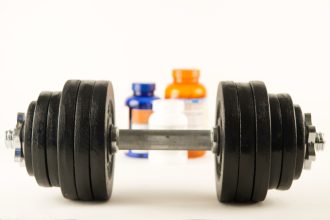When it comes to supplements for strength, muscle growth and performance, creatine is a popular option, especially creatine monohydrate. But as you start to search for this supplement, you’ll discover that other types are also available, such as creatine hydrochloride, creatine ethyl ester and buffered creatine. This may lead you to think – could these other forms be more effective than the well-known monohydrate?
Getting to know the different types available and how they perform in the body will help you decide which one better fits your needs.
First Things First: What Is Creatine?
Before exploring the different types of creatine, let’s first understand what creatine actually is. Creatine is a substance your body produces and stores mainly in the muscles and brain. Your body makes it from amino acids (the building blocks of protein), and you also get some from eating certain foods, such as meat and fish. Creatine is what helps your muscles produce energy, especially during short, quick bursts of activity, like lifting weights or sprinting.
What Are the Benefits of Taking Creatine?
When you supplement with creatine, more of it becomes available in your muscles. This gives your body more fuel to use for fast, powerful movements. Benefits you get to enjoy include:
- More strength and power: It helps you lift heavier or sprint faster.
- Better muscle recovery: It can help your muscles bounce back quicker after workouts.
- Muscle growth: Helps build muscle mass when combined with regular training
Types of Creatine
Creatine Monohydrate: The Most Researched
Monohydrate creatine is the most common form of creatine supplement. This is because most of the research on creatine supplements has been done on the creatine monohydrate type. The result of most studies has shown that it can help boost physical performance, increase muscle strength, improve endurance, support muscle growth and improve maximum power output. It is also the most affordable option.
Monohydrate creatine is made by attaching creatine to a water molecule and turning it into a powder via the crystallisation process. The powder contains about 90% pure creatine. It’s very stable if kept dry, easy for the body to absorb, and resistant to degradation during digestion, meaning most of the creatine gets absorbed.
One possible drawback of this type of creatine is that, when mixed with cold water, it often doesn’t dissolve completely. This can make your drink feel a little sandy. However, this doesn’t affect how well your body absorbs it. If you prefer a smoother drink, mixing it with warm water can help it dissolve better.
When it comes to side effects, some people may experience mild bloating when they first start taking it. This is often the result of creatine pulling more water into muscle tissue. This is totally fine, harmless and usually temporary.
Creatine Hydrochloride: More Water-Soluble
Creatine hydrochloride (HCl) is known for dissolving easily in water, which may help prevent the bloating or stomach discomfort that some people experience with creatine monohydrate. Because it mixes so well and is absorbed quickly, it’s sometimes claimed that you only need a smaller dose compared to monohydrate.
However, this idea isn’t fully backed by research. While creatine HCl does dissolve more easily, the real benefit of creatine comes from how much creatine your muscles store. Well, that doesn’t change just because a supplement dissolves faster or absorbs slightly quicker. Your body still needs the same amount of creatine to fully saturate your muscles, no matter the form.
So, while creatine hydrochloride might be easier on the stomach, the total amount of creatine your muscles need stays the same, meaning smaller doses likely won’t be enough for full benefits. However, if you experience bloating with monohydrate creatine, this could be a great option to consider.
Creatine Ethyl Ester: Enhanced Absorption
Creatine ethyl ester is considered a more bioavailable form of creatine, meaning the body absorbs it faster than monohydrate. Due to its fast absorption, it’s marketed as a form of creatine that doesn’t require a loading phase like monohydrate creatine does.
A loading phase is a period when you take a higher dose of creatine to quickly increase the amount stored in your muscles. For monohydrate creatine, this usually means taking about 20 g per day, divided into 4 doses, for 5 to 7 days. After that, you change to a smaller daily dose, usually 3 to 5 g, to maintain those levels.
Even though creatine ethyl ester absorbs more quickly, it hasn’t been shown in research to deliver better results than standard creatine monohydrate.
Buffered Creatine: Prevents Stomach Discomfort
Buffered creatine is formulated to be a more stable form of monohydrate creatine. It has a higher pH level, which means it’s less likely to break down into waste in your stomach before your body can absorb it. Because of this, some people believe it might cause less bloating or stomach discomfort compared to monohydrate.
Although buffered creatine is often sold as a better option, research shows that it doesn’t offer any significant advantages in muscle growth or performance compared to monohydrate creatine.
How Much Creatine Per Day?
Once you’ve decided on which type of creatine is best for you, it’ll be time to find out how much of it you should take per day. Taking 3 to 5 grams per day is the recommended dose. For most individuals, even active athletes, this dosage is enough, especially if they already get 1 to 2 grams of creatine naturally from foods like meat and fish. The scoop size in most creatine supplements is 5 grams.
Some individuals opt to start by following the loading phase (which I’ve explained before) to “fill up” their muscles with creatine faster. After the loading phase, they switch to the regular 3–5 grams per day for maintenance.
Following a loading phase isn’t necessary – it just speeds up how soon you’ll notice the effects. If you decide to skip it and go straight to the daily maintenance dose, it would take about 2 to 4 weeks for your muscles to fully saturate with creatine.
One thing to note is that side effects like bloating or mild stomach cramps are more common during the loading phase. Starting with a lower, steady daily dose is an effective way to avoid these side effects.














